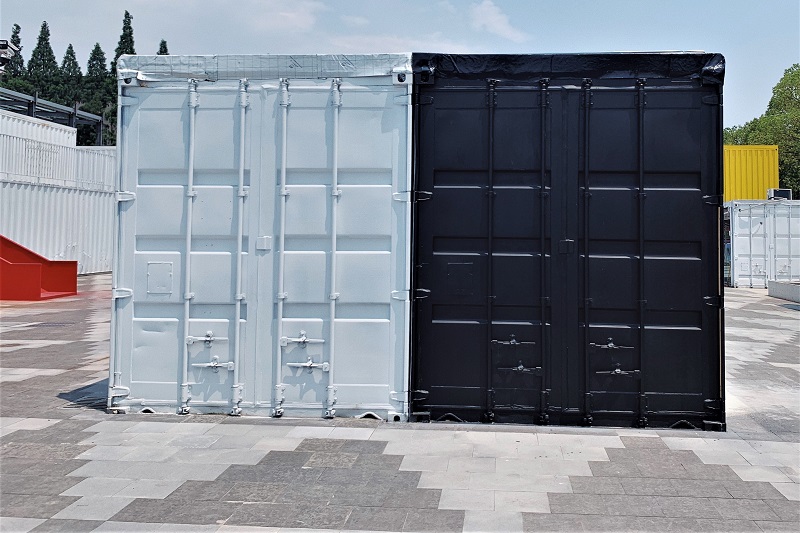
When hearing the term – Container Home – one might envision a cramped space with not much creativity involved in the design. But in reality, container architecture has, in recent years, become a popular area of study.
Houses of different sizes, stationary houses and houses on wheels, and even multiple hybrid structures that use containers in their designs have all become a topic of intense discussion in the last decade.
Because of their versatility, these shipping containers can be a valuable addition when creating the perfect tiny houses too.
Their popularity is why we thought it would be a good idea to write down the pros and cons of container homes. So, that our readers can decide for themselves— if these unusual homes are worth it!
The Top 10 Advantages of Container Homes:

- They are eco – friendly.
Container homes are all about recycling and repurposing. Shipping Containers use toughened steel, so when reusing a single shipping container, you are reusing 3000 kgs of steel. Their sustainable nature makes them ideal for the tiny house lifestyle.
The use of steel also means that there is no requirement for cement and mortar. The cement industry is one of the biggest producers of carbon monoxide and carbon dioxide emissions.
- They have structural rigidity.
As the containers do not use regular steel but Corten steel, they are highly durable. The steel is one of the strongest steels in the mechanical industry and can withstand a great deal of weight.
Even natural calamities like hurricanes and earthquakes cannot damage the structural integrity of these homes. So, you can feel safe in your home in extreme conditions as well.
- They are affordable.
Container homes demand fewer material and labor costs. They don’t require land like a brick and mortar house. Plus, they are already the ideal shape to be repurposed into rooms.
So, when compared to conventional homes, container homes are at least 30% cheaper.
- They are very versatile.
One common disadvantage of regular houses is that all the construction has to be done on the site. That limitation is not a question when building container homes because you can have it assembled in a workshop. Container homes can even be converted into tiny mobile houses.
- They are readily available.
It is very easy, especially these days, to acquire shipping containers for reuse. Many constructors and architects have also started to embrace the concept of container homes.
So, you are just an internet search away from finding a low-cost, eco-friendly tiny home for yourself.

- They are easy to customize.
Even though shipping containers have a standardized size and shape, they are easy to modify. With a proper plan and design in mind, you can create any tiny home plan to live in. You can choose an open plan with spacious windows or separate areas that can give you greater privacy. You can also easily weld things over it for storage space.
- They are safe.
The material of a shipping container doesn’t just provide longevity, but also elevated security. Steel, generally, requires high-grade equipment to cut into, which makes container homes remarkably secure to live in.
- They have a lesser turnaround time.
Depending on the intricacy of the design, a container home should take a maximum of one month to be ready to move in. Whereas brick and mortar houses take months, sometimes, years to complete and even then only the structure is complete. The interior and utility are severely lacking in them.
- They are unique.
On the surface, container homes might seem like simple homes with repetitive shapes. But, with a little careful planning and design vision, these shipping containers can make the tiny home trend seem a little more artistic. Given how easily these containers can be modified and combined to give different layouts, the homes can have a very contemporary and sophisticated look.
- They can fit large items.
If you are worried about not being able to park your cars or other vehicles near your tiny home, an extra storage container can easily function as a secure parking space.
The Top 10 Disadvantages of Container Homes:

- They may require refurbishing.
Some old storage containers might have dents, or they may be scratched. As a result, many of them require a specialized contractor to take care of these issues. As it is made of steel, the storage container can also have some rust on it.
- They are difficult to insulate.
Steel conducts both heat and electricity. This is why it is important to find a good electrician to make sure your home is comfortable and safe to inhabit. The lack of proper heat control can cause you to turn to non-sustainable solutions like energy-consuming ACs.
- They have limited spacing.
Even for a tiny home, they can have quite limited spacing. It can be difficult to find enough spacing for all the utilities. Plus, proper insulation will also take up more space.
Additional containers can be combined to create more space, but that is likely to cost more.
- They leave a greater ecological footprint.
As sustainable as reusing these containers may seem, they still leave an environmental impact. There are carbon emissions associated with the flooring, welding, and the transport of the shipping containers. You will have to pay extra attention to dispose of the produced waste properly.
- They have difficulty getting building permits.
Area compliance in different regions is different. Because the concept is still quite new in most countries, you might not always find it easy to get a permit for container homes.
- They have certain health hazards.
Shipping containers were not originally intended for human habitation. As a result, they are made using materials like chromate, phosphorus, or other lead-based materials that can be damaging to us. You will need to find a contractor who knows how to deal with these hazards beforehand.
- They may have water troubles.
During rain, water can accumulate on the roof of the container, causing rusting. If not taken care of regularly, the roofs may even start leaking. However, with some considered design, a sloping roof may be the answer. Many homes may require double stories to protect against harsh weather conditions.
- They are noisy.
Strong wind and rain can cause the insides of the containers to be very noisy. Even traffic noises and such may filter in through the thin walls of the containers. Make sure to insulate the home against outside noise as well.
- They have structural limitations.
Even though shipping containers are built using sturdy material, they were not made to be cut into. Because of this, every time you cut into the container, say for windows, or to make more space, you end up damaging the structural integrity of the containers.
- It is difficult to find experienced contractors.
Because of the specific requirements of container houses, the construction always needs experienced contractors. Whether it is welding, water-proofing, or insulation, you will need professional help. And as this is a fairly new tiny home trend, finding good and experienced contractors may prove difficult.
In conclusion, a shipping container, when used right, can be a great starting point for any contemporary tiny home. When it comes to the environment, container homes have both many advantages and many disadvantages you will need to consider.
